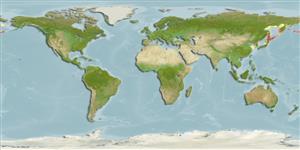>
Perciformes/Zoarcoidei (Eelpouts and pricklebacks) >
Opisthocentridae ("Rearspined fin pricklebacks")
Etymology: Pholidapus: Greek, pholis, -idos = scale + Greek, pous = feet (Ref. 45335).
Eponymy: Benedykt (Benoit) Tadeusz Dybowski (1833–1930) was a Polish biologist who was born in what is now Belarus. [...] (Ref. 128868), visit book page.
More on author: Steindachner.
Environment: milieu / climate zone / depth range / distribution range
पारिस्थितिकी
समुद्री ड़िमरसल; गहराई सीमा 0 - 146 m (Ref. 50550). Temperate
Northwest Pacific: Sea of Okhotsk to Hokkaido, the Kuril Islands, and the northern Sea of Japan.
Length at first maturity / आकार / वज़न / Age
Maturity: Lm 19.0, range 18 - 20 cm
Max length : 46.0 cm TL पुल्लिंग / अलिंग; (Ref. 56557)
Short description
पहचान कुंजी | आकृति विज्ञान | मौरफोमैटरिक्स
पृष्ठीय रीढ़ (सम्पूर्ण) : 60 - 65; पृष्ठीय सौफट रेज़ (सम्पूर्ण) : 0; गुदा कांटा: 2; ऐनल सौफट रेज़: 38 - 41.
Found in seaweed beds near shore (Ref. 43239).
Life cycle and mating behavior
परिपक्व अवधि | पुनरुत्पत्ति | मछलीऔ का अंडे देना | अंडे | Fecundity | लार्वा
Masuda, H., K. Amaoka, C. Araga, T. Uyeno and T. Yoshino, 1984. The fishes of the Japanese Archipelago. Vol. 1. Tokai University Press, Tokyo, Japan. 437 p. (text). (Ref. 559)
IUCN Red List Status (Ref. 130435: Version 2024-1)
Threat to humans
Harmless
Human uses
साधन
Special reports
Download XML
इंटरनेट स्रोत
Estimates based on models
Preferred temperature (Ref.
123201): 0.8 - 10.3, mean 3.7 °C (based on 117 cells).
Phylogenetic diversity index (Ref.
82804): PD
50 = 1.0000 [Uniqueness, from 0.5 = low to 2.0 = high].
Bayesian length-weight: a=0.00389 (0.00180 - 0.00842), b=3.12 (2.94 - 3.30), in cm total length, based on all LWR estimates for this body shape (Ref.
93245).
Trophic level (Ref.
69278): 3.4 ±0.5 se; based on size and trophs of closest relatives
Fishing Vulnerability (Ref.
59153): Moderate vulnerability (36 of 100).
Nutrients (Ref.
124155): Calcium = 41.3 [23.6, 72.4] mg/100g; Iron = 0.334 [0.196, 0.576] mg/100g; Protein = 17.9 [17.0, 18.7] %; Omega3 = 0.374 [0.207, 0.650] g/100g; Selenium = 16.3 [8.5, 31.5] μg/100g; VitaminA = 13.2 [3.8, 46.0] μg/100g; Zinc = 0.636 [0.459, 0.886] mg/100g (wet weight);
